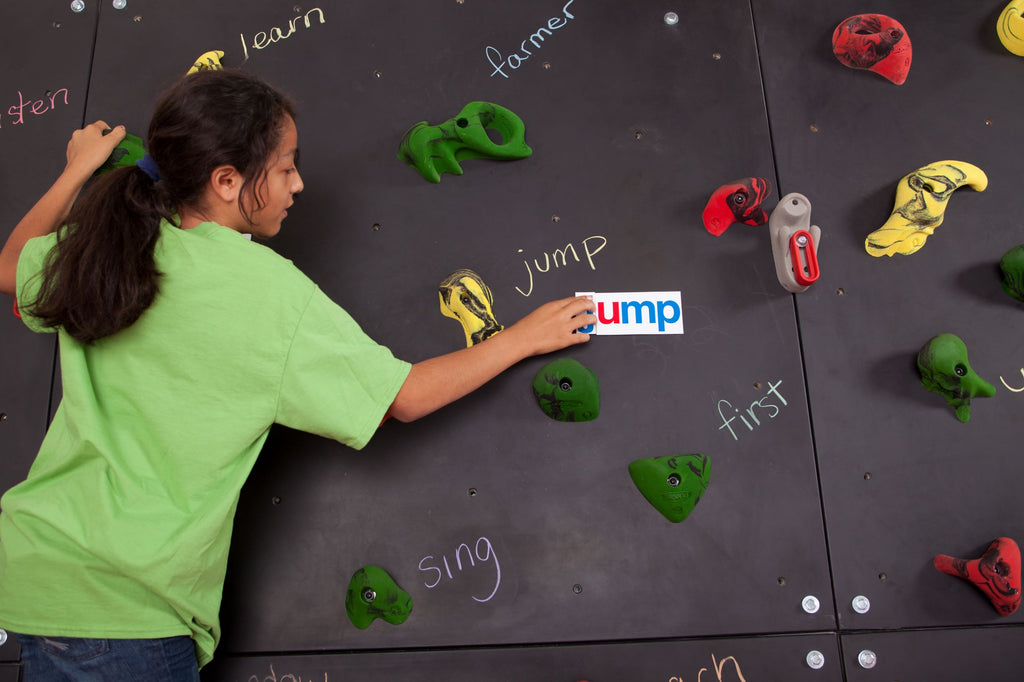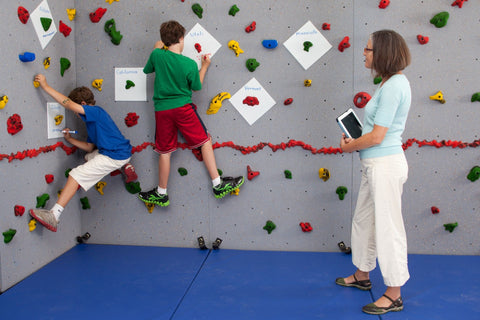
The Four Rs: Reading, wRiting, aRithmatic and Rock climbing!
Have you heard of the phrase the “Three Rs” which referenced the three basic skills taught in school? Well, we’ve updated it to four by adding rock climbing since we think physical activity is an extremely important part of education. As schools look to integrate more physical activity into the school day, using a Traverse Wall® beyond physical education class is one way to get those children moving with rock climbing. There are even ways that they can work on subject matter at the same time. Here are our suggestions to get more climbing into the school day.
Where to Start?
This initiative will have to be led by a physical educator on staff since they are the most knowledgeable about physical education/activity, the climbing wall and climbing wall protocols. Once the physical educator is on board, they will want to get support from the administration. Sharing the benefits of a Comprehensive School Physical Activity Program (CSPAP), information from the Active Schools movement and rock climbing will help make the case.
Classroom Teachers & The Climbing Wall
We recognize that not all classroom educators are familiar with rock climbing, or conducting physical activities with students, so getting their buy-in and providing climbing wall training is critical to this being successful.
Ask your principal if you can get on the schedule for an upcoming staff meeting. There you can provide a Traverse Wall 101 training to include an introduction to horizontal climbing, an overview of the parts of the climbing wall and a summary of the safety rules. Next get educators on the wall by having them try some beginner climbing activities! If you can’t be part of a staff meeting, consider introducing your fellow teachers to the climbing wall by hosting this event before or after school.
Physical Activity Break/Brain Energizer
One way that classroom educators can use the wall with their class is to take a physical activity break or a Brain Energizer on the climbing wall. Taking a break from classroom learning to climb is fun and gets children re-engaged in classroom work. This requires the classroom educator to walk the class to the gym, but a brief time on the climbing wall is a lot of fun and good exercise. The climbing wall is so popular with students, that some teachers use it as a reward. And we’re not talking about a long amount of time. 10 or 15 minutes on the wall and then students are back to work in their classrooms. Providing teachers with a lesson plan of climbing wall activities suitable for their grade level will help everyone find success using the wall to take a fun activity break.

Cross-Curricular Activity
Another way for classroom educators to use the climbing wall is to integrate it with their lessons. Here are a few ideas that integrate literacy, numeracy and climbing:
- Place letters of the alphabet or words on the climbing wall. They can be written on note cards and taped to the wall, or tucked behind the hand holds. As children climb, they can practice letter recognition, letter sounds, find the letters in their name, read site words or spell words, even the week’s spelling list. (If placing letters, be sure to duplicate frequently used letters: A, E, I, O, R, T, N, S, L and C.) Letters/words remain on the climbing wall. Climbers just point to them and don’t remove them.
- Place a variety of numbers on the climbing wall. They can be written on note cards and taped to the wall, or tucked behind the hand holds. As children climb, they can identify numbers, find fact families, add the numbers closest to each hand or practice multiplication facts. Numbers remain on the climbing wall. Climbers just point to them and don’t remove them.
- Check out this past blog post for more cross-curricular ideas.
Note: Cross-curricular activities are simplified on a Magna® Wall, Blackboard Wall, Dry-erase Wall or with Discovery Plates.
Logistics to Consider
- If the physical educator is available to assist or co-teach the first few times that teachers bring their class to the wall, it will make future sessions on the climbing wall more successful.
- Traverse Walls take up a small amount of space in the gym and can be made available to classroom teachers on days when it’s not going to be used as part of physical education classes. A classroom teacher can have their class on the wall and the physical educator can conduct activities in another area of the gym or outside with their class.
- To facilitate scheduling, the physical educator could create a schedule for when the climbing wall is available and communicate this to staff. Some schools block off a window of time and schedule teachers back-to-back. This allows them to keep the climbing mats down for a long period of time and not have to open and close the climbing wall, as putting up and taking down mats is a consideration that does take 5-10 minutes depending on the size of the wall.
- Be sure that students are very well versed in the safety rules of the climbing wall and have had previous climbing experience prior to climbing with their classroom educator. This will help alleviate management and safety issues.
- Physical educators should continue to be a resource for colleagues and regularly check in and request feedback on how climbing with their class is going.

Leave a comment